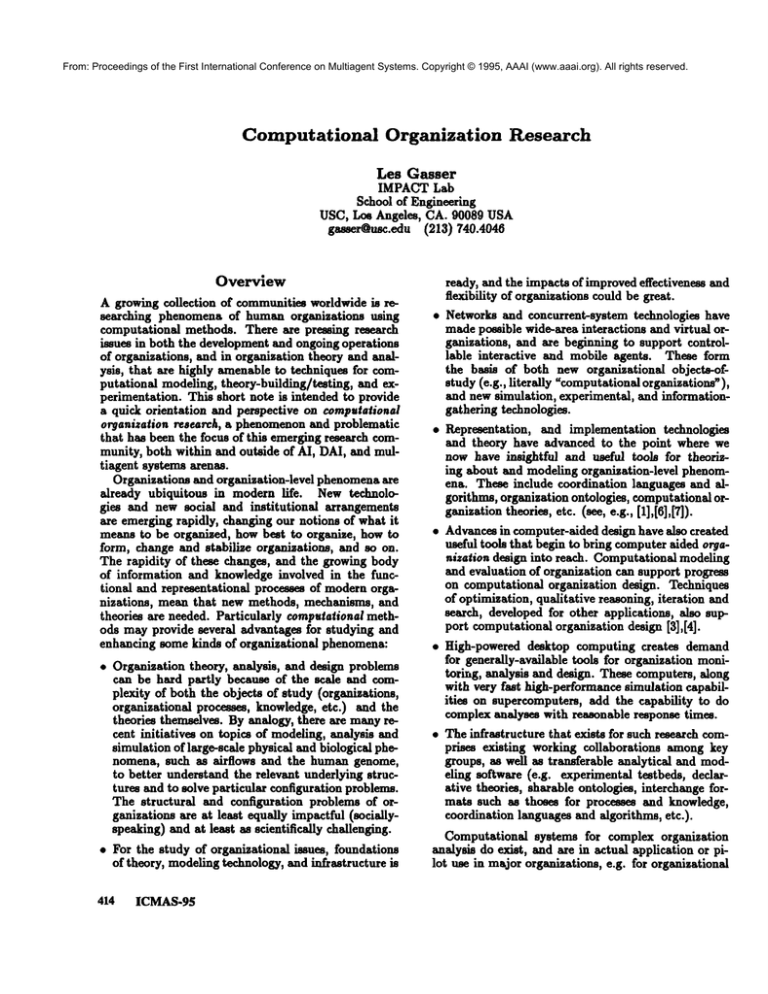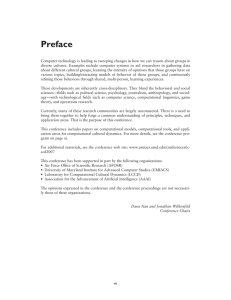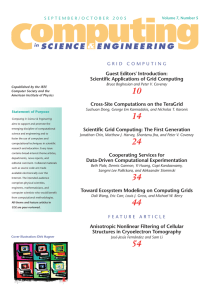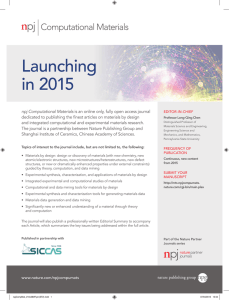
From: Proceedings of the First International Conference on Multiagent Systems. Copyright © 1995, AAAI (www.aaai.org). All rights reserved.
Computational
Organization
Research
Les Gasser
IMPACT Lab
School of Engineering
USC, Los Angeles, CA. 90089 USA
gasserOnsc.edu (213) 740.4046
Overview
A growing collection of communities worldwide is researching phenomena of human organizations
using
computational methods. There are pressing research
issues in both the development and ongoing operations
of organizations, and in organization theory and analysis, that are highly amenable to techniques for computational modeling, theory-building/testing,
and experimentation. This short note is intended to provide
a quick orientation and perspective on compmtafional
ory~nization research, a phenomenonand problematic
that has been the focus of this emerging research community, both within and outside of AI, DAI, and multiagent systems arenas.
Organizations and organization-level phenomenaare
already ubiquitous in modern life. New technologies and new social and institutional
arrangements
are emerging rapidly, changing our notions of what it
means to be organized, how best to organize, how to
form, change and stabilize organizations, and so on.
The rapidity of these changes, and the growing body
of information and knowledge involved in the functional and representational processes of modern organizations, mean that new methods, mechanisms, and
theories are needed. Particularly computational methods may provide several advantages for studying and
enhancing some kinds of organizational phenomena:
¯ Organization theory, analysis, and design problems
can be hard partly because of the scale and complexity of both the objects of study (organizations,
organizational processes, knowledge, etc.) and the
theories themselves. By analogy, there are many recent initiatives on topics of modeling, analysis and
simulation of large-scale physical and biological phenomena, such as airflows and the human genome,
to better understand the relevant underlying structures and to solve particular configuration problems.
The structural and configuration problems of organizations are at least equally impactful (sociallyspeaking) and at least as scientifically challenging.
¯ For the study of organizational issues, foundations
of theory, modeling technology, and infrastructure is
414
ICMAS-95
ready, and the impacts of improved effectiveness and
flexibility of organizations could be great.
¯ Networks and concurrent-system technologies have
madepossible wide-area interactions and virtual organizations, and are beginning to support controllable interactive and mobile agents. These form
the basis of both new organizational objects-ofstudy (e.g., literally "computationalorganizations~ ),
and new simulation, experimental, and informationgathering technologies.
¯ Representation, and implementation technologies
and theory have advanced to the point where we
now have insightful and useful tools for theorizing about and modeling organlzation-level
phenomena. These include coordination languages and algorithms, organization ontologies, computational organization theories, etc. (see, e.g., [1],[6],[7]).
¯ Advancesin computer-aided design have also created
useful tools that begin to bring computeraided organization design into reach. Computational modeling
and evaluation of organization can support progress
on computational organization design. Techniques
of optimization, qualitative reasoning, iteration and
search, developed for other applications, also support computational organization design [3] ,[4].
¯ High-powered desktop computing creates demand
for generally-available tools for organization monitorir, g, analysis and design. These computers, along
with very fast high-performance simulation capabilities on supercomputers, add the capability to do
complex analyses with reasonable response times.
¯ The infrastructure that exists for such research comprises existing working collaborations among key
groups, as well as transferable analytical and modeling software (e.g. experimental testbeds, declarative theories, sharable ontologies, interchange formats such as thoses for processes and knowledge,
coordination languages and algorithms, etc.).
Computational systems for complex organization
analysis do exist, and are in actual application or pilot use in major organizations, e.g. for organizational
From: Proceedings of the First International Conference on Multiagent Systems. Copyright © 1995, AAAI (www.aaai.org). All rights reserved.
design, analysis, re-configuration, re-engineering, and
process change (See all references below). In addition,
large research grants have been made to a number of research centers to study organization problems compurationally. It has becomeclear through a set of recent
meetings and publications that enough of an interdisciplinary organization-studics
community has emerged,
with enough familiarity with each others’ work and
enough basic interdisciplinary
knowledge to make real
inroads.
The Focus of Computational
Organization Research:
Computational organization research can be examined
along three axes:
Computational: The focus of this activity is explicitly compntationai approaches to organizational
phenomena. Example areas include computational
models and representations of organizational knowledge, explicit organizational ontologies, simulations
of organizational activity or structuring,
computational approaches to building organization theories,
coordination algorithms, computational approaches
to organization design, computational tools for organization analysis, and of course "computational
organisations’--those
organizations
made up completely or partly of computational participants--as explicit objects of study and of design.
Organization: The locus of this activity is typically mid-range, organization-level phenomena-asversns theories of individual participants (e.g. cognition
or psychology) or macro-scale phenomena (macroeconomic behavior, societal-level dynamics, institutional
interactions). This line is hard to draw, however, and
macro-mezzo-miexolinks are often of explicit interest, as are specific implications for agent-oriented and
societal-level phenomena.
Research: The locus of this activity is primarily organizational research--that is, innovations in description, analysis, theory, and methods. It is clear, however, that much good organization research is driven
by clear applied problems, and that the best practical
organizational tools embodyclear principles and theory. This line, too is hard to draw, and CORresearch
mayinclude issues in the practical application of organizational tools such as business process reengineering
tools or enterprise integration tools.
to expand.
Bibliography
1. K. Carley and M. Prietula, eds. Computational Organization Theory, Lawrence Erlbaum Associates,
Hillsdale NewJersey, 1994.
2. Cyert, 1LM., and March, J., A Behavioral TAeorg
of the Firm, Prentice-Hall, EnglewoodCliffs, NJ.,
1963.
3. Les Gasser, Ingemar Hulthage, Brian Leverich,
Jon Lieb, and Ann Majchrzak, "Organizations as
Complex, Dynamic Design Problems, ~, in Mignel
Filgneiras and Luis Damns, eds. Progress in Artificial Intelligence, Lecture Notes in Artificial Intelligence 727, Springer Verlag, 1993.
4. R. Levitt et al., ’Wile Virtual Design Team: Simulating HowOrganization Structure and Information
Processing Tools Affect TeamPerformance" in [1],
1994.
5. Masuch, M., and LaPotin, P., "Beyond Garbage
Cans: An AI Model of Organizational Choice." Adrninistmfi~e Science Quarterly, 34, pp.38-67, 1989.
6. M. Prietula, K. Carley, and L. Gasser, (Eds.) Simulating Organizations: Computational Models of Institutions
and Groups. Menlo Park, Calif.: AKAI
Press / The MITPress, 1996 (to appear).
7. C. Vogel and L. Gasser, Organizational Semiotics
Paris: Masson, 1996 (to appear).
Conclusion
Models, reasoning methods, and findings from the
standard AI repertoire can be applied usefully and effectively in the enterprise of organizational research
(e.g. [2], [5]). Conversely, models reasoning methods
from organization research can be applied in the enterprise of AI as its boundaries expand more clearly into
multiagent and distributed contexts. Together, these
syntheses promise a fertile new ground for both areas
Gasser
41S






